
Through the ‘00s, the ubiquitous reference for futuristic interaction design was the 2002 Spielberg film Minority Report. The protagonist in that movie was a cop and the notable tech in that movie was an immersive predictive policing platform and an extreme form of ID/surveillance/ad targeting that you could only avoid by surgically removing your eyes. These core aspects never came up in design discussion. For most designers, technologists and enthusiasts, it was all about the gestural experience and the layers of transparent display in high contrast lighting. And marketing managers drooled at visions of new ubiquitous, immersive, hyper-targeted augmented reality delivery channels. Though Sci-fi authors might take disturbing trends to their logical, horrifying conclusions to force difficult questions, they are often presented in seductive illustration and set design. These are inspired by and fed back to those working on the built environment IRL, often for clients with the wealth and drives of movie villains. In this way our culture actually accelerates the fruition of dystopic visions. We build what we see.
As designers, technologists and consumers, we need better visual and cultural reference points for co-creating the future. Even if design is less focused on form than it was 20 years ago, many look to the biggest corporations, tycoon-funded universities + philanthropies, and profit or investment-focused ventures for visions of the future - most of which embody the same values they have for centuries. Though seductive, user-friendly, frictionless, delightful or innovative, they often have ugly externalities, dependencies or contradictions that are at the root of our biggest problems.
There are more sustainable, equitable visions that can come out of entirely different structures, cultures, sensibilities and formal vocabularies. They may come from writers, researchers, independent artists, activists, community projects or (sub)cultures that seem marginal if your primary focus is Hollywood blockbusters. PF seeks to amplify and contextualize inspiring work, often around a common theme, and use better tools to do it . The goal is to help practitioners and users contextualize our work, inform our choices, and increase the chances of making radically different futures possible.
